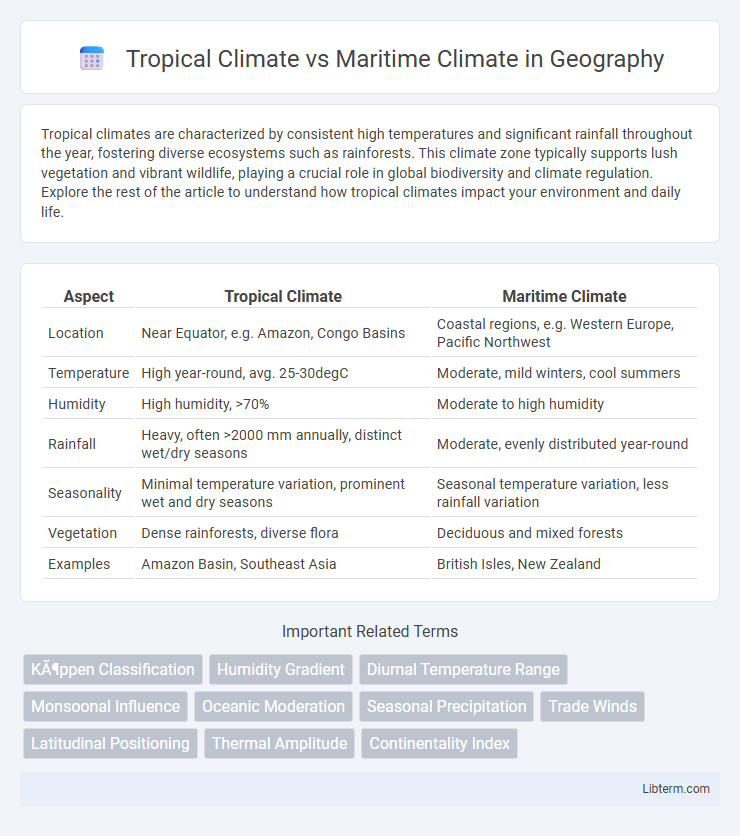Tropical climates are characterized by consistent high temperatures and significant rainfall throughout the year, fostering diverse ecosystems such as rainforests. This climate zone typically supports lush vegetation and vibrant wildlife, playing a crucial role in global biodiversity and climate regulation. Explore the rest of the article to understand how tropical climates impact your environment and daily life.
Table of Comparison
| Aspect | Tropical Climate | Maritime Climate |
|---|---|---|
| Location | Near Equator, e.g. Amazon, Congo Basins | Coastal regions, e.g. Western Europe, Pacific Northwest |
| Temperature | High year-round, avg. 25-30degC | Moderate, mild winters, cool summers |
| Humidity | High humidity, >70% | Moderate to high humidity |
| Rainfall | Heavy, often >2000 mm annually, distinct wet/dry seasons | Moderate, evenly distributed year-round |
| Seasonality | Minimal temperature variation, prominent wet and dry seasons | Seasonal temperature variation, less rainfall variation |
| Vegetation | Dense rainforests, diverse flora | Deciduous and mixed forests |
| Examples | Amazon Basin, Southeast Asia | British Isles, New Zealand |
Overview of Tropical and Maritime Climates
Tropical climates are characterized by consistently high temperatures above 18degC year-round, with abundant rainfall supporting lush vegetation, commonly found near the equator. Maritime climates experience mild to cool temperatures with moderate to high precipitation influenced by proximity to large bodies of water, typically located along coastal regions in mid-latitudes. These distinctions in temperature variability and moisture availability define the unique ecosystems and weather patterns of tropical and maritime climates.
Key Characteristics of Tropical Climates
Tropical climates are characterized by consistently high temperatures averaging above 18degC (64degF) year-round and significant humidity, resulting in lush vegetation and frequent heavy rainfall, often exceeding 2000 mm annually. These climates experience little temperature variation across seasons but have distinct wet and dry periods, heavily influenced by the Intertropical Convergence Zone (ITCZ). In contrast, maritime climates feature milder temperatures with smaller annual ranges due to the moderating influence of nearby oceans and tend to have more evenly distributed precipitation throughout the year.
Key Characteristics of Maritime Climates
Maritime climates are characterized by mild temperatures year-round, with cool summers and relatively warm winters due to the moderating influence of nearby oceans. High humidity and frequent precipitation, often in the form of consistent rain, are typical, supporting lush vegetation and preventing extreme temperature fluctuations. These climates are commonly found along western coasts of continents, influenced by prevailing westerly winds and ocean currents.
Temperature Variability: Tropical vs Maritime
Tropical climates exhibit minimal temperature variability, with consistently high temperatures ranging between 25degC and 30degC year-round due to their location near the equator. Maritime climates experience moderate temperature variability, influenced by the proximity to oceans that stabilize temperature fluctuations, typically ranging from 10degC to 20degC seasonally. This contrast highlights how oceanic influence in maritime regions reduces extremes, while tropical zones maintain steady heat throughout the year.
Rainfall Patterns and Distribution
Tropical climates exhibit high rainfall concentrated in distinct wet and dry seasons, with annual precipitation often exceeding 2000 mm and heavily influenced by the Intertropical Convergence Zone (ITCZ). Maritime climates feature more evenly distributed rainfall throughout the year, averaging between 600 and 1500 mm annually, due to consistent oceanic moisture and prevailing westerly winds. The contrast in rainfall patterns affects vegetation, agriculture, and water resource management in regions dominated by these climates.
Humidity Levels and Seasonal Changes
Tropical climates maintain consistently high humidity levels year-round, often exceeding 70%, with minimal seasonal variation due to their proximity to the equator. Maritime climates experience moderate humidity levels, typically ranging between 60% and 80%, influenced by oceanic air masses and prevailing winds that create marked seasonal changes. Seasonal temperature shifts in maritime climates lead to fluctuating humidity, while tropical climates remain relatively stable with abundant rainfall supporting dense vegetation.
Biodiversity and Ecosystems Comparison
Tropical climates support rich biodiversity with lush rainforests hosting diverse species adapted to warm, humid conditions year-round. Maritime climates feature moderate temperatures and higher precipitation variability, fostering temperate forests and coastal ecosystems with species adapted to fluctuating moisture and temperature levels. The stability of tropical climate conditions promotes complex, multi-layered habitats, while maritime climates sustain resilient ecosystems shaped by oceanic influences and seasonal changes.
Human Adaptation and Lifestyle Differences
Tropical climates with high temperatures and heavy rainfall require humans to adapt through lightweight clothing, elevated housing designs for ventilation, and diets rich in fresh fruits and hydration to combat heat and humidity. Maritime climates, characterized by moderate temperatures and high humidity, influence lifestyles with layered clothing, coastal housing built to withstand moist conditions, and diets that include seafood and preserved foods to manage variable weather. Human adaptation in these climates reflects a balance between environmental conditions and resource availability, shaping cultural practices and daily living patterns.
Economic Impacts of Each Climate Type
Tropical climates, characterized by high temperatures and abundant rainfall, foster agriculture industries such as sugarcane, coffee, and tropical fruits, driving local economies but also facing risks from extreme weather events like hurricanes. Maritime climates, with mild temperatures and consistent precipitation, support diversified economies including fishing, forestry, and tourism, while benefiting from stable weather that reduces agricultural volatility. Each climate's economic impact is shaped by their distinct environmental conditions, influencing regional development, resource management, and climate resilience strategies.
Climate Change Effects on Tropical and Maritime Regions
Tropical climates experience intensified heatwaves and altered precipitation patterns due to climate change, leading to more frequent droughts and flooding that threaten biodiversity and agriculture. Maritime climates face rising sea levels and increased storm intensity, resulting in coastal erosion and saltwater intrusion impacting freshwater resources and human settlements. Both regions require adaptive strategies to manage climate vulnerability and sustain ecological and economic stability.
Tropical Climate Infographic

 libterm.com
libterm.com